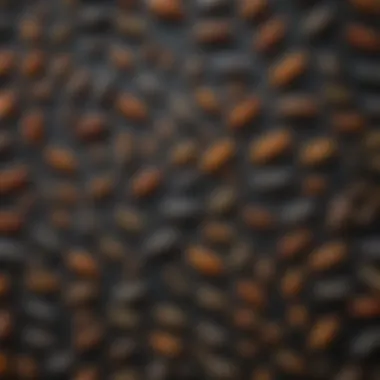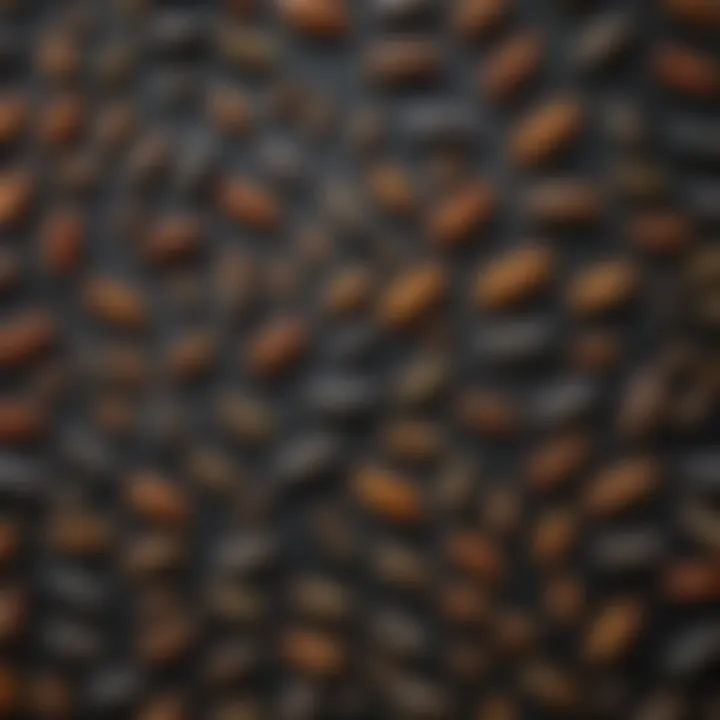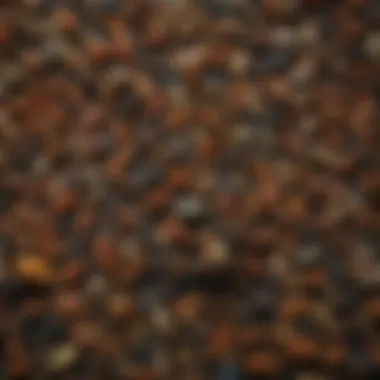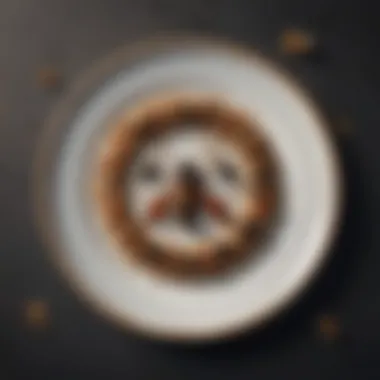Exploring Entomophagy: Insect Consumption Insights


Intro
The idea of eating insects can be as foreign as a long-lost language, especially in parts of the world where bugs are mainly seen as pests. Yet, with climate change and dwindling natural resources playing a significant role in how we think about food, the consumption of insects, also known as entomophagy, is becoming a topic worth exploring. People are not just raising eyebrows; they're raising forks at the prospect of incorporating insects into their daily diets.
A growing awareness of nutrition and sustainability is steering attention toward insects as a viable food source. They are rich in protein, vitamins, and minerals, presenting an alternative to traditional meats. It might make some wrinkle their noses initially, but the nutritional profile might just make you reconsider.
In this article, we will navigate the various aspects connected to buying insects for consumption. From understanding its significance and cultural standing, to wrapping our heads around how to purchase them, the impact of eating insects on our planet, and even some scrumptious recipes – there’s a lot to unpack. Let’s take this unexpected culinary journey together.
Preface to Entomophagy
Entomophagy, the practice of consuming insects, is not just a curiosity but a burgeoning movement that reflects our changing relationship with food. As we grapple with the implications of climate change, sustainability, and food security, insects are emerging as a viable alternative protein source. This section delves into the importance of understanding entomophagy in today’s context, especially given the pressing need for innovative food solutions.
Insects are remarkably efficient in converting feed into protein, using far less land and water compared to traditional livestock such as cattle or pigs. As global populations rise and urbanization expands, the demand for food continues to outstrip supply, creating fertile ground for alternative foods like insects to take root.Specialty shops for various edible insects have started popping up, signaling a shift in consumer preferences.
Moreover, buying insects can open doors to a deeper appreciation of local ecosystems and biodiversity. With over 2,000 species of edible insects identified worldwide, this practice can promote conservation efforts and sustainable agricultural practices, benefiting farmers and the environment alike. Understanding the layers of history behind this practice can also highlight its relevance in various cultures around the world, from the protein-rich chapulines of Mexico to the crickets celebrated in Thai cuisine.
As we progress through this exploration, we will uncover why entomophagy isn't simply a trend but a potential necessity that might redefine our diets in sustainable and nutritionally rich ways.
Definition and Overview
Entomophagy refers to the human consumption of insects. While it might sound novel in western diets, it is standard in many parts of the world, with roughly two billion people adding insects to their meals regularly. This practice is not only about adding variety to diets but also offers significant nutritional benefits. Insects are packed with protein, healthy fats, vitamins, and minerals, serving as a powerhouse of nutrition in compact forms.
The advantages of incorporating insects into one's diet align directly with the ongoing global dialogue on sustainable food sources. As we see traditional farming methods facing challenges – like climate impacts and resource scarcity – insect farming may be a key player, efficiently producing high-quality food in a smaller footprint.
Historical Context
Historically, the consumption of insects finds its roots in many ancient civilizations. Evidence points to the discovery of bugs being eaten as far back as 9,000 years ago within various indigenous groups. In fact, “native tribes in North America” have relied on insects as a source of sustenance long before modern diets were even considered. In places like China, traditional practices involving insect consumption have been deeply ingrained in culture.
Across continents, from the termite delicacies of Africa to the silkworm larvae in Korea, entomophagy has evolved based on local availability and culinary needs. However, as industrialization took hold, many cultures that once revered insect consumption either shifted their diets or stigmatized the practice. The growing awareness of health and environment concerns has begun to turn the tide, encouraging many to revisit and embrace this ancient practice once more.
In summary, the historical context of entomophagy illustrates how intertwined it is with various cultures and evolving human diets. As we consider the challenges of modern food systems, this ancient practice is resurfacing as a viable solution, inviting individuals to rethink their perceptions of food.
Nutritional Aspects of Insects
Understanding the nutritional profile of insects is paramount, especially as the world shifts towards more sustainable food sources. Insects present a unique opportunity to not just diversify diets, but also to provide essential nutrients that might be lacking in conventional livestock.
Protein Content and Quality
One key attraction of consuming insects is their remarkable protein content. Insects are often considered a complete source of protein, which means they provide all essential amino acids necessary for human health. For instance, crickets contain about 60% protein by dry weight, making them a powerhouse in terms of nutritional value.
The protein digestibility in insects is comparable to that found in beef and chicken. This means that the body can absorb and utilize the protein efficiently. Additionally, the quality of proteins derived from insects is indeed high, often boasting better digestibility coefficients than other meat sources. This can be especially beneficial for agriculturalists and health-conscious individuals alike, seeking efficient ways to boost protein intake without the environmental costs associated with traditional farming.
Vitamins and Minerals
When one digs deeper into the nutritional well of insects, a treasure trove of vitamins and minerals emerges. Insects like mealworms are rich in B vitamins, including B12—an essential nutrient often lacking in a vegetarian diet. Furthermore, they provide significant amounts of iron, zinc, and magnesium, which are crucial for a functioning immune system and metabolic processes.
Each type of insect offers a different mineral makeup. For instance, locusts are known to have higher concentrations of calcium, whereas ants are often cited for their high selenium content, which aids in antioxidant actions within the body. Exploring such variances not only enhances dietary patterns but also opens up avenues for nutrition blending based on local insect varieties available.
"Insects are not only nutritious, but they can also be raised with a fraction of the resources it takes for traditional livestock, making them both a smart and a sustainable choice for food security."
Healthy Fats
Insects are also a source of healthy fats, contributing to overall well-being. Many insects contain a balanced ratio of polyunsaturated fatty acids, including omega-3 and omega-6 fatty acids. These fats are essential for brain health and optimal cardiovascular functioning.
For instance, crickets have been found to harbor around 20% fat on average, much of which is unsaturated. This quality makes insects a viable alternative to fatty red meats, especially for those watching their fat intake. The concept of incorporating insects into diets as a way to enjoy healthy fats shines bright, guiding enthusiasts and practical farmers alike toward a pathway of health.
Consolidating the information regarding the nutrition provided by insects can help enlighten skeptics and enthusiasts. The journey of integrating these nutritional powerhouses into diets not only carries promise for health but holds the potential for environmental benefits through minimized resource use.


Environmental Impact of Insect Farming
Understanding the environmental impact of insect farming is crucial, especially in the context of global food scarcity and climate change. As people look for sustainable solutions in food production, insects present an intriguing option. They can play an important role in reducing the ecological footprint associated with traditional livestock farming.
Resource Efficiency Compared to Traditional Livestock
When examining food sources, it's vital to consider how efficiently they convert feed into edible mass. Insects like crickets and mealworms thrive on organic waste products, turning otherwise unusable materials into protein without the extensive water and land use commonly found in cattle or poultry farming. Notably, crickets require a mere 1.7 kilograms of feed to produce 1 kilogram of body weight, whereas cattle need around 8 kilograms of feed for the same outcome. This stark difference in feed conversion ratios is pivotal since it highlights the insects’ efficiency in leveraging resources.
- Land Use: Farming crickets, for instance, requires about 80% less land than raising cattle. This can significantly reduce the strain on our forests and grasslands, allowing natural habitats to flourish.
- Water Consumption: Similarly, insects consume substantially less water. Producing 1 kilogram of crickets uses approximately 2,000 liters of water in comparison to over 15,000 liters for a kilogram of beef.
This efficiency not only conserves vital resources but also reduces the overall cost of food production, encouraging a shift towards a more sustainable agricultural model.
Reduction of Carbon Footprint
The contribution of livestock farming to greenhouse gas emissions is staggering. According to some studies, livestock agriculture accounts for roughly 14.5% of all human-induced emissions. Insect farming, by contrast, offers a more eco-friendly approach. The processes involved in raising insects result in markedly fewer emissions, thanks in large part to their high-feed conversion rates and lower resource requirements.
- Methane Production: Ruminant animals like cows produce methane, a potent greenhouse gas, during digestion. Insects do not produce methane, which means the environmental impact isn't amplified through waste production.
- Nitrous Oxide Emissions: Insect farming generates significantly lower levels of nitrous oxide—a greenhouse gas generated primarily through livestock manure and fertilizer use—further supporting its status as an environmentally conscious choice.
"Insect rearing can help curtail greenhouse gas emissions while providing diverse sources of protein."
By opting for insects as a protein source, we could witness a notable decline in global warming potential associated with food production.
In sum, investing in insect farming could be seen as a practical solution to current environmental challenges. As agricultural practices evolve, embracing the resource efficiency and reduced carbon footprint of insect farming might just be the way forward in establishing a more sustainable food system.
Buying Insects: Where and How
In the journey of integrating insects into our diet, knowing where and how to buy them is crucial. The availability of insects for consumption varies greatly depending on the region, type of insect, and the consumers’ individual preferences. This section brings forward the significant avenues through which one can procure these protein-rich creatures, spanning online retail, local markets, and even home-grown options.
Online Retailers
The digital market brings insects right to your doorstep. With just a few clicks, you can explore a range of edible insects offered by various online retailers. Many websites specialize in insect products, providing detailed descriptions along with the nutritional benefits of different species. This option is particularly beneficial for individuals who may not have local access to these goods and prefer the convenience of home delivery.
Shopping online often allows for comparing prices and reading customer reviews, which helps in making informed decisions. However, one must be cautious. Check if the retailer adheres to safety standards and regulations regarding insect farming. Look for certified products, ensuring you’re consuming safe and high-quality options. Popular online platforms like Bugible and Cricket Flour Co. provide a selection of gourmet insect snacks and protein powders, making it easy for beginners to incorporate insects into their diet without the initial discomfort of sourcing them locally.
Local Markets and Specialty Stores
For those who relish a more hands-on approach, local markets and specialty stores are invaluable resources. Visiting a farmers market can connect you with local insect farmers who understand the nuances of their products. Often, these vendors provide not only insects but also guidance on preparation and cooking methods.
In urban areas, health food stores frequently carry edible insects or insect-based products. Items like roasted crickets or mealworm protein bars often find a place in the snack aisle. Taste-testing samples can also ease any apprehension about flavor or texture. It’s worth noting that knowledge about local regulations regarding insect sales is quite variable, so ensuring compliance with food safety should be a priority.
DIY Farming Options
For the adventurous and sustainability-minded, growing your own insects can be a rewarding endeavor. DIY farming not only guarantees you have a steady supply but also allows you to control their diet and environment. Crickets, mealworms, and ants are among the easiest insects to rear at home, requiring minimal space and investment.
Starting your own mini-insect farm can be as straightforward as setting up an enclosure with the right humidity and temperature, tracking their growth, and eventually harvesting them for consumption. Various online resources provide step-by-step guides and community support, making it accessible even for beginners. Local agricultural extension offices may also offer workshops on insect farming, allowing participants to learn directly from experts.
Important Consideration: While there are benefits to DIY insect farming, one must also consider the commitment required. Regular maintenance and scrutiny of optimal conditions are key to a productive operation. Always ensure that safety protocols are in place when dealing with live insects, especially if you intend to consume them.
Legal Regulations and Food Safety
The practice of entomophagy, which is rapidly growing in popularity due to the increasing interest in sustainable food sources, is not without its regulatory challenges. Navigating the legal landscape is crucial for both producers and consumers. Understanding the regulations surrounding the sale and consumption of insects can not only ensure food safety but also promote a responsible market for edible insects.
In many regions, insects must meet specific food safety guidelines to be considered suitable for consumption. This segment delves into the global regulations that govern insect farming and sales, along with the safety standards that protect consumers.
Overview of Global Regulations
Entomophagy is practiced in various parts of the world, yet the regulations vary significantly. In countries such as Thailand and Mexico, insects are a staple in the local diet, while in other regions, it's relatively new. Different governments approach the legality of insect consumption based on cultural acceptances and economic benefits.
For example, in the European Union, the sale of insects as food is subjected to the Novel Food Regulation, requiring approval before products can be put on the market. This ensures that any insect product meets strict food safety standards before gaining entry to grocery shelves. Here are some notable regulations:


- European Union: Insects must be approved as novel foods, undergoing rigorous assessments centered on safety, nutritional value, and production method.
- United States: The Food and Drug Administration (FDA) oversees insect sales. They are considered safe as long as they are produced and handled in accordance with safety laws.
- Australia: The states vary in their regulations; some allow consumption while others have restrictions, often focusing on risks associated with harvesting insects from the wild.
These differences can make cross-border trade tricky and often necessitate a robust understanding of local regulations. This emphasizes the importance for consumers and producers alike to stay informed about the legality of insect consumption in specific locales.
Safety Standards for Consumption
When it comes to consuming insects, safety is paramount. Strict safety standards ensure that the insects we eat are free from pathogens and harmful substances. Here are a few crucial aspects to consider:
- Source Control: Insects should be sourced from reputable farms. Wild harvesting can expose consumers to risks such as pesticides or pollutants.
- Processing and Handling: Proper processing methods are essential. This includes cleaning, cooking, and storage techniques to prevent contamination.
- Nutritional Integrity: Insect products must also ensure that they retain their nutritional benefits. This involves minimal processing to keep flavors and nutrients intact.
Regulatory bodies often implement testing protocols for insect farms to confirm their adherence to these safety standards. For instance, some farms are routinely inspected to ensure compliance, giving consumers the peace of mind regarding the quality of what they consume.
"It's more than just taste; it’s about health and safety when it comes to what we put on our plates."
With the strengthening of regulatory measures and safety standards, the future of entomophagy looks promising. As this practice continues to evolve, understanding these aspects will be key to navigating the landscape of edible insects responsibly.
Cultural Perspectives on Eating Insects
Exploring entomophagy extends beyond just understanding the nutritional benefits and environmental impact; it importantly involves examining the cultural attitudes towards eating insects. The acceptance and enthusiasm for insects as a food source are deeply rooted in cultural norms, traditions, and values. This section elucidates how regional practices shape perceptions and consumption of insects, highlighting both the widespread acceptance in some cultures as well as the challenges faced in others.
Entomophagy in Different Regions
Across the globe, the practice of eating insects is as diverse as the people who partake in it. In many parts of Asia, Africa, and Latin America, entomophagy is not just a nutritional strategy; it is an integral part of culinary heritage. For instance, in Thailand, crispy fried crickets are served as a popular snack, and their sales have been booming in local markets. In Mexico, chapulines (grasshoppers) are seasoned with garlic, lime, and salt and are a cherished delicacy in various dishes.
Conversely, in Western nations, the concept of eating insects can elicit disgust or apprehension. The general mindset often leans toward the belief that insects are unclean or undesirable, a perception shaped by cultural upbringing and media portrayals. However, a subtle shift is occurring in places like the United States and Europe, where gourmet chefs are beginning to incorporate insects into their menus, advocating for their culinary value and sustainability.
This cultural dichotomy provides vital insights into how entomophagy might be further integrated into diets worldwide. For example, understanding how markets in Asia have successfully embraced insect consumption offers potential pathways for Western societies to follow.
Cultural Barriers to Acceptance
Despite the evident advantages of including insects in diets, several cultural barriers persist that hinder their acceptance. One key aspect is the longstanding stigma associated with insects as food. In societies where insects are typically viewed as pests or harbingers of filth, it can be extremely challenging to shift public perception.
Recent studies highlight several barriers to acceptance:
- Lack of Awareness: Many individuals simply do not know about the nutritional benefits of insects, which can foster skepticism.
- Cultural Norms: Dietary habits form early and are usually resistant to change. Families and communities pass down traditions that may eschew insects entirely.
- Marketing and Representation: The absence of appealing marketing strategies makes it hard for insect products to gain ground in mainstream food culture. Insect-based foods need exciting packaging and narratives to attract curious consumers.
"Shifting perceptions requires a cultural revolution that starts with education and visibility in food markets."
Promoting entomophagy as a sustainable food source involves not only addressing the cultural perception issues but also actively engaging in education. Culinary workshops and tasting events can play a pivotal role in demystifying insect consumption. By showcasing the versatility of insects and providing education on their preparation, people may begin to view them not with aversion, but as a delicious and responsible choice for future diets.
Culinary Uses of Insects
Culinary uses of insects represent a fascinating intersection of tradition and innovation in the kitchen. It illustrates not only the versatility of insects as a food source but also their cultural significance across various societies. For those interested in integrating insects into their diets, understanding these culinary applications is crucial. The flavors and textures insects bring to the table can enhance a dish in surprising ways. Moreover, they fit well within the framework of sustainability, making them a wise choice for the environmentally-conscious eater.
Traditional Recipes Featuring Insects
Many cultures worldwide have embraced insects in their cooking for centuries, often without any stigma attached. For instance, in many parts of Mexico, chapulines, or toasted grasshoppers, are a beloved delicacy. They are commonly seasoned with lime, garlic, and salt before being enjoyed as a snack or a topping on tacos. This traditional recipe showcases how insects can be blended seamlessly into local cuisines, enhancing familiar flavors with a unique twist.
Another example can be found in Cambodia, where fried crickets are a popular street food. They are known for their crispy texture and are often served with a side of dipping sauce. This centuries-old practice not only underscores the insect's prevalence in local diets but also highlights the community aspect of enjoying food together—a tradition that goes beyond mere sustenance.
In Canada, some Indigenous communities incorporate insects like ants into traditional dishes. Ants, when harvested correctly, can be a natural sugar source that infuses sweetness into various recipes. Traditional practices utilize their unique flavor profiles in sauces or desserts, reflecting teachings passed through generations about respecting and utilizing nature efficiently.
- Key Points in Traditional Insect Recipes:
- Integral part of the culture and traditions.
- Provides unique flavors and textures.
- Encourages community and shared experiences in food.
Innovative Dishes and Modern Cuisine
As culinary landscapes evolve, so does the experimentation with insects in modern cuisine. Renowned chefs and food enthusiasts are continuously pushing boundaries, creating innovative dishes that incorporate insects in gourmet ways. For instance, consider the rise of cricket flour in baking. This gluten-free ingredient is loaded with protein and can be blended into pancakes, cookies, and even pasta.


You may also find dishes like mealworm tacos in high-end restaurants, reimagined to appeal to a broader audience while maintaining the integrity of traditional flavors. By pairing these insects with high-quality ingredients and sophisticated cooking techniques, chefs bring attention to entomophagy in a way that appeals even to the most discerning diners.
The fusion cuisine trend is another area where insects are gaining traction. Imagine a sushi roll made with silkworms or a rice bowl topped with roasted ants. These dishes not only challenge perceptions but also open up discussions around sustainability, flavor, and nutrition in food sourcing.
"The future of food is diverse and inclusive. Embracing insects in our diets can bridge culinary gaps across cultures."
In creating these innovative dishes, chefs often aim to soften consumer resistance by presenting insects in their most palatable forms. Integration into widely accepted cuisines makes it easier for people to give them a try, paving the way for a more sustainable future in dining.
- Trending Modern Insect Dishes Include:
- Cricket flour pancakes or cookies.
- Mealworm tacos in fine dining settings.
- Sushi rolls featuring silkworms.
- Rice bowls topped with roasted ants.
In short, embracing insects in culinary practices provides a pathway to not only diversify diets but also to contribute positively to the environment. The culinary uses of insects, therefore, prove both practical and innovative, making them a valuable addition to modern diets.
Challenges and Considerations
Understanding the challenges and considerations in entomophagy is crucial for anyone delving into this fascinating and sustainable source of nutrition. There's often a gap between the recognition of insects as a viable food source and the practical realities of integrating them into one’s diet. This section highlights those hurdles while also uncovering the benefits of addressing them.
Consumer Perception and Acceptance
Consumer perception plays a pivotal role in the acceptance of insects as food. Many people in Western cultures view insects with skepticism or outright disdain. This stems from various factors, including cultural norms, lack of familiarity, and misinformation. For instance, in many societies, insects are relegated to the status of pests rather than a protein source. This negative stereotype can be a considerable barrier to acceptance.
However, there's a shift happening as more individuals become aware of the environmental benefits of insect farming and its nutritional potential. Reports indicate that nearly 80% of the world’s population consumes insects in some form, signaling that cultural perspectives are shifting, albeit slowly, in regions where this practice is less ingrained.
To turn the tide, producers and advocates of entomophagy need to employ effective marketing strategies that highlight the nutritional value of insects, such as their high protein content and essential vitamins. Other approaches can include engaging infographics, cooking demonstrations, and taste-testing events that can initially ease people into the idea of eating insects. It’s about changing perceptions through experience and evidence, gradually leading consumers to see insects in a new light.
"The insect protein market is anticipated to grow as more consumers learn about the sustainability and health benefits."
Educational Efforts Needed
As interest in entomophagy grows, so does the need for educational programs aimed at both consumers and producers. Knowledge is power, and without proper education, the myths surrounding insect consumption will likely persist. Schools, culinary programs, and community workshops should include information on the benefits of insects, preparation techniques, and safety considerations, thus addressing any apprehensions.
Some key areas to focus on in educational efforts:
- Nutritional Benefits: Providing clear data on the nutritional superiority of insects compared to traditional animal protein sources.
- Culinary Techniques: Offering cooking classes focused on easy and palatable ways to incorporate insects into meals.
- Environmental Impact: Sharing information about how insect farming is less resource-intensive than traditional livestock. This also speaks to eco-conscious consumers looking for sustainable options.
By prioritizing education and gradually fostering understanding, the hope is to shift public opinion, making the idea of consuming insects as normal as selecting chicken or beef.
These challenges and considerations are not merely hurdles; they represent opportunities for innovation and growth in the food industry. By tackling the misconceptions and enhancing knowledge, we pave the way for a more sustainable diet that includes these little critters.
Future Trends in Insect Consumption
The increasing interest in sustainable food sources has set the stage for a remarkable evolution in the practice of eating insects. As concerns about climate change and food security mount, the consumption of insects is slowly creeping into mainstream diets, particularly in Western countries where this practice has long been overlooked. This section delves into significant trends shaping the future of insect consumption, focusing on the growing popularity in Western diets and the pivotal role of technology in production.
Growing Popularity in Western Diets
Several factors drive the rising acceptance of insects in Western culinary practices. One clear motivator is the push for sustainability. Consumers are becoming more conscious of the environmental impact of traditional meat consumption. Insects, requiring significantly less land, water, and feed, provide a sustainable alternative for protein. When you look closely, it’s almost mind-blowing how a handful of crickets can achieve the same protein output as a herd of cows but with a fraction of the resources.
The aesthetics of food also has its role. Social media platforms like Instagram showcase culinary creativity, and edible insects are beginning to appear in exciting recipes that catch consumers’ eyes. Buzz around unique dishes featuring insects helps break down the mental barriers that have stopped many from embracing entomophagy.
"We are what we eat," a common saying, rings true as insects make their way onto plates, transforming perceptions of what is deemed acceptable fare.
Moreover, the influence of global travel has exposed many to diverse culinary practices. As food culture becomes more fusion-oriented, Western palates are opening up to experiences that once seemed bizarre or unappealing. People are starting to realize that if they can enjoy exotic dishes from far-off lands, they can certainly experiment with insect-based snacks or even incorporate them into traditional meals.
Despite these advances, challenges remain. Some consumers are cautious, associating insect consumption solely with survival situations or alternative diets. The perception of insects as pests rather than a viable food source can create a mental block. However, as education around the nutritional benefits and cultural practices surrounding entomophagy grows, the gap in acceptance is expected to narrow.
The Role of Technology in Production
The future of insect consumption will predominantly hinge on advancements in agricultural technology. Innovative techniques in raising and processing insects can significantly enhance efficiency and safety, addressing concerns that skeptical consumers often voice.
Food tech companies are now harnessing artificial intelligence and automation to optimize insect farming. For instance, precision farming techniques can ensure that the insects are raised in optimal conditions, which can enhance their growth and nutritional content.
Additionally, technology can reduce the cost of production and, in turn, market prices. As techniques improve, the mass production of insects may become more economically viable, making them a more accessible option to average consumers.
Moreover, research into developing insect-based protein supplements is crucial. These products could be added to various foods, extending insect consumption far beyond snacks – imagine protein bars or meal replacements featuring cricket flour. This integration could make insects a familiar part of everyday diets, opening up new revenue streams while normalizing this protein source in mainstream markets.



